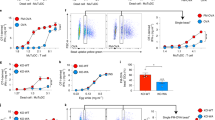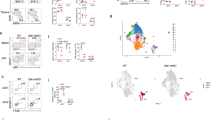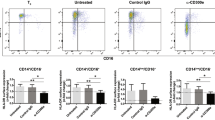Abstract
Immunoreceptor tyrosine-based activation motifs (ITAMs) are crucial in antigen receptor signaling in acquired immunity. Although receptors associated with the ITAM-bearing adaptors FcRγ and DAP12 on myeloid cells have been suggested to activate innate immune responses, the mechanism coupling those receptors to 'downstream' signaling events is unclear. The CARMA1–Bcl-10–MALT1 complex is critical for the activation of transcription factor NF-κB in lymphocytes but has an unclear function in myeloid cells. Here we report that deletion of the gene encoding the Bcl-10 adaptor–binding partner CARD9 resulted in impaired myeloid cell activation of NF-κB signaling by several ITAM-associated receptors. Moreover, CARD9 was required for Toll-like receptor–induced activation of dendritic cells through the activation of mitogen-activated protein kinases. Although Bcl10−/− and Card9−/− mice had similar signaling impairment in myeloid cells, Card11−/− (CARMA1-deficient) myeloid cell responses were normal, and although Card11−/− lymphocytes were defective in antigen receptor–mediated activation, Card9−/− lymphocytes were not. Thus, the activation of lymphoid and myeloid cells through ITAM-associated receptors or Toll-like receptors is regulated by CARMA1–Bcl-10 and CARD9–Bcl-10, respectively.
This is a preview of subscription content, access via your institution
Access options
Subscribe to this journal
Receive 12 print issues and online access
$209.00 per year
only $17.42 per issue
Buy this article
- Purchase on Springer Link
- Instant access to full article PDF
Prices may be subject to local taxes which are calculated during checkout








Similar content being viewed by others
References
DeFranco, A.L. Transmembrane signaling by antigen receptors of B and T lymphocytes. Curr. Opin. Cell Biol. 7, 163–175 (1995).
Humphrey, M.B., Lanier, L.L. & Nakamura, M.C. Role of ITAM-containing adapter proteins and their receptors in the immune system and bone. Immunol. Rev. 208, 50–65 (2005).
Maeda, A., Kurosaki, M. & Kurosaki, T. Paired immunoglobulin-like receptor (PIR)-A is involved in activating mast cells through its association with Fc receptor γ chain. J. Exp. Med. 188, 991–995 (1998).
Ono, M., Yuasa, T., Ra, C. & Takai, T. Stimulatory function of paired immunoglobulin-like receptor-A in mast cell line by associating with subunits common to Fc receptors. J. Biol. Chem. 274, 30288–30296 (1999).
Lopez-Botet, M. et al. Paired inhibitory and triggering NK cell receptors for HLA class I molecules. Hum. Immunol. 61, 7–17 (2000).
Kanazawa, N., Tashiro, K., Inaba, K. & Miyachi, Y. Dendritic cell immunoactivating receptor, a novel C-type lectin immunoreceptor, acts as an activating receptor through association with Fc receptor γ chain. J. Biol. Chem. 278, 32645–32652 (2003).
Merck, E. et al. OSCAR is an FcRγ-associated receptor that is expressed by myeloid cells and is involved in antigen presentation and activation of human dendritic cells. Blood 104, 1386–1395 (2004).
Colonna, M. TREMs in the immune system and beyond. Nat. Rev. Immunol. 3, 445–453 (2003).
Bakker, A.B., Baker, E., Sutherland, G.R., Phillips, J.H. & Lanier, L.L. Myeloid DAP12-associating lectin (MDL)-1 is a cell surface receptor involved in the activation of myeloid cells. Proc. Natl. Acad. Sci. USA 96, 9792–9796 (1999).
Tomasello, E. et al. Association of signal-regulatory proteins β with KARAP/DAP-12. Eur. J. Immunol. 30, 2147–2156 (2000).
Shiratori, I., Ogasawara, K., Saito, T., Lanier, L.L. & Arase, H. Activation of natural killer cells and dendritic cells upon recognition of a novel CD99-like ligand by paired immunoglobulin-like type 2 receptor. J. Exp. Med. 199, 525–533 (2004).
Aguilar, H. et al. Molecular characterization of a novel immune receptor restricted to the monocytic lineage. J. Immunol. 173, 6703–6711 (2004).
Wright, G.J. et al. Characterization of the CD200 receptor family in mice and humans and their interactions with CD200. J. Immunol. 171, 3034–3046 (2003).
Yotsumoto, K. et al. Paired activating and inhibitory immunoglobulin-like receptors, MAIR-I and MAIR-II, regulate mast cell and macrophage activation. J. Exp. Med. 198, 223–233 (2003).
Daeron, M. Fc receptor biology. Annu. Rev. Immunol. 15, 203–234 (1997).
Merck, E. et al. Fc receptor γ-chain activation via hOSCAR induces survival and maturation of dendritic cells and modulates Toll-like receptor responses. Blood 105, 3623–3632 (2005).
Klesney-Tait, J., Turnbull, I.R. & Colonna, M. The TREM receptor family and signal integration. Nat. Immunol. 7, 1266–1273 (2006).
Bouchon, A., Facchetti, F., Weigand, M.A. & Colonna, M. TREM-1 amplifies inflammation and is a crucial mediator of septic shock. Nature 410, 1103–1107 (2001).
Brown, G.D. Dectin-1: a signalling non-TLR pattern-recognition receptor. Nat. Rev. Immunol. 6, 33–43 (2006).
Young, S.H., Ye, J., Frazer, D.G., Shi, X. & Castranova, V. Molecular mechanism of tumor necrosis factor-α production in 1 → 3-β-glucan (zymosan)-activated macrophages. J. Biol. Chem. 276, 20781–20787 (2001).
Rogers, N.C. et al. Syk-dependent cytokine induction by dectin-1 reveals a novel pattern recognition pathway for C type lectins. Immunity 22, 507–517 (2005).
Ruland, J. et al. Bcl10 is a positive regulator of antigen receptor-induced activation of NF-κB and neural tube closure. Cell 104, 33–42 (2001).
Ruefli-Brasse, A.A., French, D.M. & Dixit, V.M. Regulation of NF-κB-dependent lymphocyte activation and development by paracaspase. Science 302, 1581–1584 (2003).
Ruland, J., Duncan, G.S., Wakeham, A. & Mak, T.W. Differential requirement for Malt1 in T and B cell antigen receptor signaling. Immunity 19, 749–758 (2003).
Klemm, S. et al. The Bcl10-Malt1 complex segregates Fc epsilon RI-mediated nuclear factor κB activation and cytokine production from mast cell degranulation. J. Exp. Med. 203, 337–347 (2006).
Hara, H. et al. The MAGUK family protein CARD11 is essential for lymphocyte activation. Immunity 18, 763–775 (2003).
Hara, H. et al. The molecular adapter Carma1 controls entry of IκB kinase into the central immune synapse. J. Exp. Med. 200, 1167–1177 (2004).
Xue, L. et al. Defective development and function of Bcl10-deficient follicular, marginal zone and B1 B cells. Nat. Immunol. 4, 857–865 (2003).
Bertin, J. et al. CARD9 is a novel caspase recruitment domain-containing protein that interacts with BCL10/CLAP and activates NF-κB. J. Biol. Chem. 275, 41082–41086 (2000).
Gross, O. et al. Card9 controls a non-TLR signalling pathway for innate anti-fungal immunity. Nature 442, 651–656 (2006).
Gantner, B.N., Simmons, R.M., Canavera, S.J., Akira, S. & Underhill, D.M. Collaborative induction of inflammatory responses by dectin-1 and Toll-like receptor 2. J. Exp. Med. 197, 1107–1117 (2003).
Saijo, S. et al. Dectin-1 is required for host defense against Pneumocystis carinii but not against Candida albicans. Nat. Immunol. 8, 39–46 (2007).
Underhill, D.M. et al. The Toll-like receptor 2 is recruited to macrophage phagosomes and discriminates between pathogens. Nature 401, 811–815 (1999).
Ozinsky, A. et al. The repertoire for pattern recognition of pathogens by the innate immune system is defined by cooperation between Toll-like receptors. Proc. Natl. Acad. Sci. USA 97, 13766–13771 (2000).
Hida, S., Nagi-Miura, N., Adachi, Y. & Ohno, N. Beta-glucan derived from zymosan acts as an adjuvant for collagen-induced arthritis. Microbiol. Immunol. 50, 453–461 (2006).
Kobayashi, K. et al. RICK/Rip2/CARDIAK mediates signalling for receptors of the innate and adaptive immune systems. Nature 416, 194–199 (2002).
Lu, C. et al. Participation of Rip2 in lipopolysaccharide signaling is independent of its kinase activity. J. Biol. Chem. 280, 16278–16283 (2005).
Dong, W. et al. The IRAK-1–BCL10-MALT1-TRAF6–TAK1 cascade mediates signaling to NF-κB from Toll-like receptor 4. J. Biol. Chem. 281, 26029–26040 (2006).
Hsu, Y.M. et al. The adaptor protein CARD9 is required for innate immune responses to intracellular pathogens. Nat. Immunol. 8, 198–205 (2007).
Seki, E. et al. Critical roles of myeloid differentiation factor 88-dependent proinflammatory cytokine release in early phase clearance of Listeria monocytogenes in mice. J. Immunol. 169, 3863–3868 (2002).
Torres, D. et al. Toll-like receptor 2 is required for optimal control of Listeria monocytogenes infection. Infect. Immun. 72, 2131–2139 (2004).
Wang, D. et al. CD3/CD28 costimulation-induced NF-κB activation is mediated by recruitment of protein kinase C-θ, Bcl10, and IκB kinase β to the immunological synapse through CARMA1. Mol. Cell. Biol. 24, 164–171 (2004).
Pomerantz, J.L., Denny, E.M. & Baltimore, D. CARD11 mediates factorspecific activation of NF-κB by the T cell receptor complex. EMBO J. 21, 5184–5194 (2002).
Sommer, K. et al. Phosphorylation of the CARMA1 linker controls NF-κB activation. Immunity 23, 561–574 (2005).
Matsumoto, R. et al. Phosphorylation of CARMA1 plays a critical role in T Cell receptor-mediated NF-κB activation. Immunity 23, 575–585 (2005).
Liu, Y. et al. BCL10 mediates lipopolysaccharide/toll-like receptor-4 signaling through interaction with Pellino2. J. Biol. Chem. 279, 37436–37444 (2004).
Kawai, T., Adachi, O., Ogawa, T., Takeda, K. & Akira, S. Unresponsiveness of MyD88-deficient mice to endotoxin. Immunity 11, 115–122 (1999).
Yamamoto, M., Takeda, K. & Akira, S. TIR domain-containing adaptors define the specificity of TLR signaling. Mol. Immunol. 40, 861–868 (2004).
Yanagawa, Y. & Onoe, K. Distinct regulation of CD40-mediated interleukin-6 and interleukin-12 productions via mitogen-activated protein kinase and nuclear factor κB-inducing kinase in mature dendritic cells. Immunology 117, 526–535 (2006).
Chin, A.I. et al. Involvement of receptor-interacting protein 2 in innate and adaptive immune responses. Nature 416, 190–194 (2002).
Yoneyama, M. et al. The RNA helicase RIG-I has an essential function in double-stranded RNA-induced innate antiviral responses. Nat. Immunol. 5, 730–737 (2004).
Kato, H. et al. Cell type-specific involvement of RIG-I in antiviral response. Immunity 23, 19–28 (2005).
Koga, T. et al. Costimulatory signals mediated by the ITAM motif cooperate with RANKL for bone homeostasis. Nature 428, 758–763 (2004).
Acknowledgements
We thank N. Suzuki, S. Yamasaki, and T. Yokosuka for discussions; H. Arase (Osaka University) and N. Kanazawa (Wakayama Medical University) for reagents; S. Akira (Osaka University) for Myd88−/− mice and Tlr2−/−; X. Lin (University of Texas M.D. Anderson Cancer Center) for reagents, discussions and sharing unpublished data; and H. Yamaguchi and M. Ikari for secretarial assistance. Expression plasmids pCMVSPORT-IRAK1, pcDNA3-RIP2–myc and pRK6–myc-Bcl-10 were provided by T.W. Mak (Campbell Family Institute for Breast Cancer Research and Ontario Cancer Institue), N. Inohara (The University of Michigan Medical School) and X. Lin (University of Texas M.D. Anderson Cancer Center), respectively. Supported by a Grant-in-Aid for Priority Area Research from the Ministry of Education, Culture, Sports, Science and Technology of Japan, the National Cancer Institute (R01 CA87064 to S.W.M.), Cancer Center (CORE grant CA21765), the Council of Scientific and Industrial Research (Government of India; S.K.P.), the Department of Biotechnology (Government of India) and the American Lebanese Syrian Associated Charities of St. Jude Children's Research Hospital.
Author information
Authors and Affiliations
Contributions
H.H. designed and did experiments and wrote the paper; C.I., A.T. and H.K. made knockout mice; T.I. did experiments; L.X., S.W.M., S.S. and Y.I. provided knockout mice; M.I., T.T., A.S. and N.O. provided antibodies or reagents; H.Y. and J.M.P. contributed to discussions; and T.S. designed experiments and wrote the paper.
Corresponding authors
Ethics declarations
Competing interests
The authors declare no competing financial interests.
Supplementary information
Supplementary Fig. 1
Gene targeting of Card9. (PDF 78 kb)
Supplementary Fig. 2
Normal development of lymphocytes, macrophages, and dendritic cells in Card9−/− mice. (PDF 143 kb)
Supplementary Fig. 3
Normal cytokine responses of BMDCs from Card9−/− mice upon stimulation by anti-CD40 or PMA plus calcium ionophore. (PDF 43 kb)
Supplementary Fig. 4
Expression profiles of Carma1 mRNA in immune cells. (PDF 53 kb)
Supplementary Fig. 5
Real-time RT-PCR analysis of Il6 mRNA from loxoribine-stimulated Card9−/− DCs. (PDF 42 kb)
Supplementary Fig. 6
TLR-induced cytokine response in Card9−/− macrophages. (PDF 71 kb)
Supplementary Fig. 7
CARD9 and RIP2 synergistically induce Bcl10 phosphorylation and MAPK activation. (PDF 64 kb)
Supplementary Fig. 8
Two types of 'CBM' complexes control activation signals through ITAM-receptors and TLRs in lymphoid and myeloid cells. (PDF 42 kb)
Rights and permissions
About this article
Cite this article
Hara, H., Ishihara, C., Takeuchi, A. et al. The adaptor protein CARD9 is essential for the activation of myeloid cells through ITAM-associated and Toll-like receptors. Nat Immunol 8, 619–629 (2007). https://doi.org/10.1038/ni1466
Received:
Accepted:
Published:
Issue Date:
DOI: https://doi.org/10.1038/ni1466
This article is cited by
-
Macrophage CARD9 mediates cardiac injury following myocardial infarction through regulation of lipocalin 2 expression
Signal Transduction and Targeted Therapy (2023)
-
Cutaneous wound healing promoted by topical administration of heat-killed Lactobacillus plantarum KB131 and possible contribution of CARD9-mediated signaling
Scientific Reports (2023)
-
DOCK2 regulates antifungal immunity by regulating RAC GTPase activity
Cellular & Molecular Immunology (2022)
-
Card9 protects sepsis by regulating Ripk2-mediated activation of NLRP3 inflammasome in macrophages
Cell Death & Disease (2022)
-
CARD9 Expression Pattern, Gene Dosage, and Immunodeficiency Phenotype Revisited
Journal of Clinical Immunology (2022)



